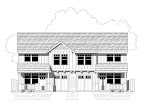What we are figuring out is the amount of heat that is lost from the house in several ways. One way is by conduction through the envelope. Another way is by convection through leaks in the house. Most factors are known but several need to be looked up. Once you know those values for your area, you can use them again and again.
Let's establish those values. First you will need to establish your highest desired indoor temperature. During winter this might be 62°F or 65°F or 68°F. We'll use 65°F for this guide. Next you'll want to establish the coldest outdoor temperature that might be experienced. For the walls this might be 20°F or 0°F or -20°F if you're in Alaska. We'll assume 20°F for this guide.
Beware however that your crawlspace and attic will have different cold temperatures. If your insulation is in the ceiling plane instead of the roof plane, your attic will enjoy the comfort of being enclosed even though it won't be insulated. Therefore in 20°F weather the attic may register at 40°F. The same situation is present in the crawl space, especially if it's vented and any walls adjacent to a garage. We'll use 40°F for these three locations.
Using these temperatures establish a difference of temperature known as ΔT (delta-T). This is simply subtracting the coldest outside temperature from the desired indoor temperature. Using our established values the walls, windows, and exterior doors will have a ΔT of 45°F and the crawl space and attic will have a ΔT of 25°F.
Next you'll need to gather the areas of each of the parts of your building envelope. This includes floors, walls, ceilings, windows, and doors. Rather than figure the exact wall area, imagine there are no windows or doors. Then when you do the window and door areas, you can subtract them from the wall area to get a more accurate reading with less calculation. If you want to be especially precise, you can note the amount of wall against the garage, second floor walls against first floor attics, etc. We'll skip that precision.
The other thing you'll need to gather is the U-value of those components. U-value is the inverse of R-value. U-value should also take into account the whole assembly and not just the insulation itself. An R-21 batt does not equal an R-21 wall. A typical R-21 wall will end up at about R-16, that is, a U-value of 1/16 or .0625. A simple true R-value conversion can be had by multiplying your insulation R-value by a factor depending on quality. For a standard average build, assume 75% of your insulation value. For good construction (24" o.c. R-30 wall for example) assume 80%. If you're using exterior foam, figure your percentage value and then add the foam. For instance, an average R-21 wall works out to about R-16 but adding 1-1/2" of XPS foam adds R-7.5 for a total of R-23.5, U-value of .0426. More precision is better but don't go crazy.
Let's put it all together:
The general equation for each element is area x u-value x ΔT. You should write down the following:
- Afloor x Ufloor x ΔTfloor = Btu/hr floor
- Awall x Uwall x ΔTwall = Btu/hr wall
- Aceil x Uceil x ΔTceil = Btu/hr ceil
- Awindows x Uwindows x ΔTwindows = Btu/hr windows
- Adoor x Udoor x ΔTdoor = Btu/hr door
Next week: Infiltration!






No comments:
Post a Comment